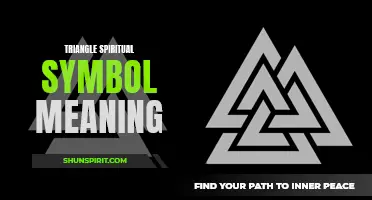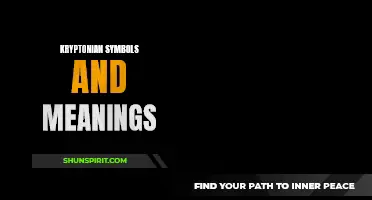
Discrete math is a field of mathematics that focuses on studying mathematical structures that are fundamentally discrete rather than continuous. It plays a crucial role in computer science, cryptography, and many other areas. In this field, symbols have great significance as they represent concepts, operations, relationships, and more. Understanding these symbols is essential for comprehending the language and logic of discrete math, allowing us to unlock the secrets hidden within its equations and theorems. So, let's dive into the world of discrete math symbols and unravel their meanings in this fascinating realm of mathematics.
What You'll Learn
- What are some common discrete math symbols and their meanings?
- How do discrete math symbols differ from symbols used in other branches of mathematics?
- Are all symbols in discrete math universal or do they vary based on different textbooks or authors?
- Can discrete math symbols be used interchangeably with symbols from other branches of math?
- Are there any resources or guides available for learning and understanding discrete math symbols and their meanings?

What are some common discrete math symbols and their meanings?
Discrete mathematics is a branch of mathematics that deals with mathematical structures that are fundamentally discrete rather than continuous. In discrete mathematics, symbols are used to represent various concepts and operations. These symbols are used to provide a concise and precise way of expressing mathematical ideas. Understanding these symbols is crucial for understanding and working with discrete mathematics. In this article, we will explore some common discrete math symbols and their meanings.
- Union (⋃): The symbol "⋃" represents the union of two or more sets. The union of two sets A and B is denoted by A ⋃ B and is defined as the set that contains all the elements that are in A or B or both.
- Intersection (⋂): The symbol "⋂" represents the intersection of two or more sets. The intersection of two sets A and B is denoted by A ⋂ B and is defined as the set that contains all the elements that are in both A and B.
- Subset (⊆): The symbol "⊆" represents the subset relationship between two sets. If every element of set A is also an element of set B, then we say that A is a subset of B, denoted by A ⊆ B.
- Proper Subset (⊂): The symbol "⊂" represents the proper subset relationship between two sets. If A is a subset of B, but A is not equal to B, then we say that A is a proper subset of B, denoted by A ⊂ B.
- Power Set (P): The symbol "P" represents the power set of a set. The power set of a set A is denoted by P(A) and is defined as the set that contains all possible subsets of A, including the empty set and the set itself.
- Complement ('): The symbol "'" represents the complement of a set. The complement of a set A, denoted by A', is the set that contains all the elements that are not in A but are in the universal set.
- Element ( ∈ ): The symbol "∈" represents the element-of relationship between an element and a set. If x is an element of a set A, then we say that x belongs to A, denoted by x ∈ A.
- Not Element ( ∉ ): The symbol "∉" represents the not-element-of relationship between an element and a set. If x is not an element of a set A, then we say that x does not belong to A, denoted by x ∉ A.
- Cardinality ( | | ): The symbol " | | " represents the cardinality or the number of elements in a set. If A is a set, then |A| represents the cardinality of A.
- Logical Operators: Discrete mathematics often involves the use of logical operators. Some common logical operators include "∧" (and), "∨" (or), "¬" (not), "⇒" (implies), and "⇔" (if and only if). These symbols are used to represent logical relationships between propositions.
These are just some of the common symbols used in discrete mathematics. Understanding and being able to work with these symbols is essential for successfully navigating and solving problems in discrete mathematics. By familiarizing yourself with these symbols and their meanings, you will be better equipped to understand and apply discrete mathematical concepts.
Unraveling the Mystical Meaning and Symbolism Behind Shooting Stars
You may want to see also

How do discrete math symbols differ from symbols used in other branches of mathematics?
Discrete math is a branch of mathematics that deals with objects that can only take on certain values. It focuses on the study of finite or countable sets and is used in various fields such as computer science, cryptography, and combinatorics. In order to explain concepts and ideas in discrete math, various symbols are used. These symbols differ from symbols used in other branches of mathematics in several ways.
Firstly, discrete math symbols often represent relationships between objects rather than specific values. For example, the symbol "∈" is used in set theory to indicate that an element belongs to a set. This symbol is not concerned with the specific value of the element, but rather the relationship between the element and the set. In contrast, symbols used in other branches of mathematics, such as "+", "-", "*", and "/", represent specific arithmetic operations and their values.
Secondly, in discrete math, symbols are often used to represent logical operators and connectives. These symbols are used to manipulate logical expressions and establish logical relationships between propositions. Examples of such symbols include "∧" (logical conjunction), "∨" (logical disjunction), and "¬" (logical negation). These symbols are not commonly used in other branches of mathematics, which typically focus on numerical operations and equations.
Another difference between discrete math symbols and symbols used in other branches of mathematics is their notation and representation. Discrete math symbols often use concise and compact notations to represent mathematical concepts and ideas. For example, the symbol "∑" is used to represent summation, where the sum of a series of values is denoted by the Greek letter sigma followed by the index range of the series. In contrast, symbols used in other branches of mathematics may have different notations and representations depending on the specific field or context.
Furthermore, discrete math symbols also include specialized notation for combinatorial and probability concepts. For example, the symbol "!" is used to represent factorial, which is used to calculate the number of possible arrangements or combinations of objects. The symbol "nCr" is used to represent the binomial coefficient, which calculates the number of ways to choose a specific number of objects from a larger set. These symbols are unique to discrete math and are not commonly used in other branches of mathematics.
In conclusion, discrete math symbols differ from symbols used in other branches of mathematics in terms of their representation, notation, and the types of concepts they represent. Discrete math symbols often represent relationships between objects, logical operators, and specialized concepts such as combinatorics and probability. Understanding these symbols is essential for studying and applying discrete math concepts in various fields.
Unveiling the Enigmatic Symbolism of Pomegranates: A Deeper Meaning Behind the Ruby-Red Fruit
You may want to see also

Are all symbols in discrete math universal or do they vary based on different textbooks or authors?
In the field of discrete mathematics, symbols play a crucial role in representing mathematical concepts and operations. They provide a concise and universal language for mathematicians to communicate their ideas. However, the use of symbols in discrete math can sometimes vary based on different textbooks or authors.
While many symbols are generally agreed upon and widely used across the discipline, there are instances where variations occur. This is especially true for less commonly used symbols or symbols that represent specific concepts that may differ in different branches of discrete mathematics.
One example of a widely accepted symbol is the symbol for "for all" (∀). This symbol is used to indicate that a given statement holds true for all elements in a set. It is universally recognized and used in almost all textbooks and research articles in discrete mathematics.
Similarly, the symbol for "there exists" (∃) is another commonly used symbol in discrete math. It denotes the existence of at least one element in a set that satisfies a given property. Like the symbol for "for all," the symbol for "there exists" is generally agreed upon and used consistently across different sources.
However, there are cases where variations occur. For example, some textbooks might use different symbols to represent the logical connectives "and" (∧) and "or" (∨). While the majority of sources use these symbols, there might be instances where alternative symbols such as "+" or "∪" are used instead.
Another area where variations in symbols may occur is in the representation of mathematical functions and operations. While the basic arithmetic operators such as addition (+), subtraction (-), multiplication (* or ×), and division (/ or ÷) are universally recognized and used, there might be variations in the symbols used for more complex functions or operations.
For instance, the notation for summation (∑) is widely used to represent the sum of a series of numbers. However, some textbooks or authors may use alternative symbols such as Σ or S instead. Similarly, symbols for other mathematical functions such as factorial (!), power (^), or logarithm (log) might also vary in different sources.
It is important for readers of discrete mathematics to be aware of these variations in symbols and notation. When studying from different sources or when communicating with other mathematicians, it is essential to understand the context and meaning of the symbols being used. In case of ambiguity, it is always best to consult the specific textbook or author to clarify any doubts.
In conclusion, while many symbols in discrete mathematics are universal and widely accepted, there can be variations based on different textbooks or authors. It is crucial for mathematicians to be aware of these variations and to understand the context in which symbols are used. By doing so, they can effectively communicate and understand the concepts and ideas in the field of discrete mathematics.
The Rich Meanings Behind Native Symbols: A Window into Indigenous Cultures
You may want to see also

Can discrete math symbols be used interchangeably with symbols from other branches of math?
Discrete math is a branch of mathematics that deals with structures that are fundamentally countable. It includes topics such as logic, set theory, combinatorics, graph theory, and more. Like any other branch of mathematics, discrete math has its own set of symbols and notation that are specific to the discipline. However, can these symbols be used interchangeably with symbols from other branches of math?
In general, symbols in mathematics are used to represent specific concepts, operations, or relationships. While many symbols are used across different branches of math, their meaning can vary depending on the context in which they are used. This means that while some symbols in discrete math may have similar or even identical counterparts in other branches of math, their interpretation can differ.
For example, consider the symbol "+" which represents addition in basic arithmetic. This symbol is also used in many other branches of math, including algebra, calculus, and even discrete math. However, in discrete math, the "+" symbol may be used to denote the operation of logical OR instead. Similarly, the symbol "*" which typically represents multiplication in arithmetic can be used in certain contexts in discrete math to denote the operation of logical AND.
Another example of a symbol that may have different meanings in discrete math is the symbol "∈" which typically represents the membership relation in set theory. In discrete math, this symbol may be used to denote the relation of divisibility instead. This illustrates how symbols can have different interpretations and uses depending on the branch of math in which they are employed.
It is worth noting that although symbols in discrete math may have different meanings in other branches of math, there is often an overlap in terms of notation. This can be particularly useful when studying interdisciplinary topics or when applying concepts from discrete math in other areas of mathematics. In such cases, it is important to clearly define the meaning of symbols and notation to avoid confusion and ensure that the correct interpretation is understood.
In conclusion, while some symbols in discrete math may have counterparts in other branches of math, their interpretation can vary. Symbols and notation in mathematics are context-dependent and their meaning is determined by the branch of math in which they are used. Understanding the specific meanings of symbols is crucial to accurately interpreting mathematical expressions and concepts.
Unraveling the Mysteries Behind the Triforce Symbol: Its Ancient Origins and Symbolic Meaning
You may want to see also

Are there any resources or guides available for learning and understanding discrete math symbols and their meanings?
Discrete math is a branch of mathematics that deals with discrete objects or objects that are separated and distinct from one another. It is widely used in computer science, cryptography, and various other fields. Understanding and interpreting the symbols used in discrete math is crucial to mastering the subject. Fortunately, there are several resources and guides available that can help you learn and understand these symbols and their meanings.
One of the best resources for learning discrete math symbols is a good textbook on the subject. There are many textbooks available that cover discrete math comprehensively, and they often include detailed explanations and examples of the symbols used. Look for a textbook that is specifically designed for beginners or for self-study, as these tend to provide a more accessible introduction to the subject.
In addition to textbooks, there are also online resources and guides that can help you learn and understand discrete math symbols. Websites such as Khan Academy and MIT OpenCourseWare offer free online courses on discrete math that cover a wide range of topics, including the symbols and notation used. These courses often include video lectures, practice problems, and interactive quizzes, making it easier to grasp the concepts and symbols.
Another helpful resource for learning discrete math symbols is online forums and communities dedicated to the subject. These forums often have dedicated sections or threads where you can ask questions about specific symbols or notation and receive answers from experienced practitioners. Participating in these forums can provide valuable insights and clarification on the meanings and applications of the symbols used in discrete math.
Finally, practice is key to understanding and interpreting discrete math symbols. Many resources and guides mentioned above include exercises and practice problems that allow you to apply what you've learned. Solving these problems and actively working with the symbols will help solidify your understanding and improve your ability to interpret them.
In conclusion, there are several resources and guides available for learning and understanding discrete math symbols and their meanings. Textbooks, online courses, forums, and practice problems can all be valuable tools in this process. By utilizing these resources and actively engaging with the symbols, you can gain a solid understanding of discrete math notation and its applications.
Decoding the Hidden Meanings Behind IKEA Symbols
You may want to see also
Frequently asked questions
The symbol "∀" in discrete math represents the universal quantifier, which is a way to express that a given statement holds true for all elements in a set or domain. For example, if we say "∀x(x > 0)", it means that for every element x in the set of real numbers, x is greater than 0.
The symbol "∃" in discrete math represents the existential quantifier, which is a way to express that there exists at least one element in a set or domain that satisfies a given statement. For example, if we say "∃x(x > 0)", it means that there exists at least one element x in the set of real numbers that is greater than 0.
The symbol "∈" in discrete math represents the element-of relation, which is used to denote that an element belongs to a set. For example, if we say "x ∈ A", it means that the element x belongs to the set A. Similarly, if we say "5 ∈ {1,2,3,4,5}", it means that the number 5 is an element of the set {1,2,3,4,5}.







